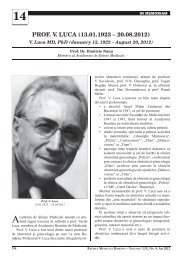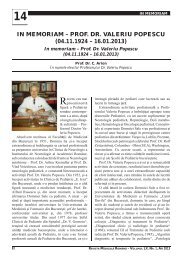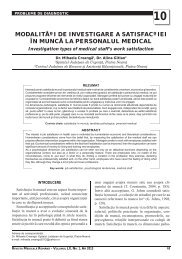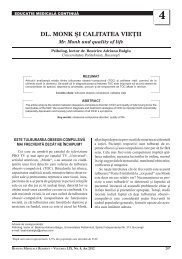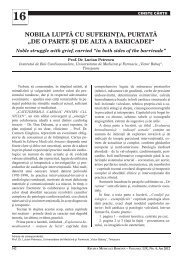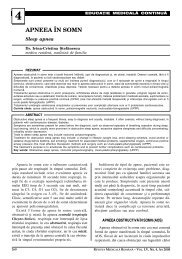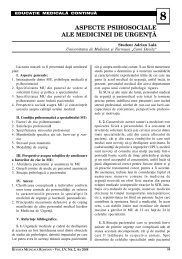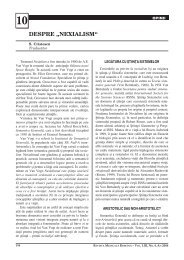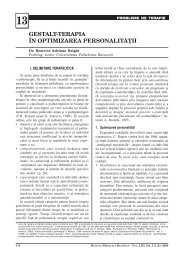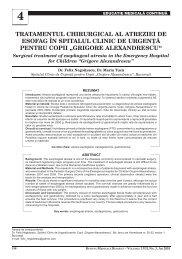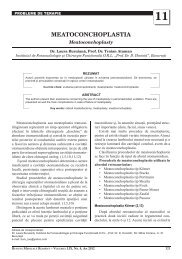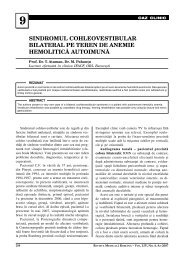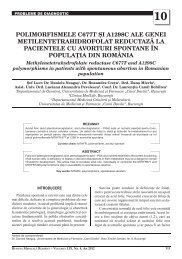Create successful ePaper yourself
Turn your PDF publications into a flip-book with our unique Google optimized e-Paper software.
138<br />
2. Misch C.E., Dietsch F. Bone-grafting materials in implant dentistry. Implant<br />
Dent, 1993<br />
<st<strong>ro</strong>ng>3.</st<strong>ro</strong>ng> Gher M., Quinte<strong>ro</strong> G., Assad D., et al. Bone Grafting and guided bone<br />
regeneration for immediate dental implants in humans. J Periodontol, 1994<br />
Peri-implanti ti s versus periodonti ti s –<br />
similariti es and diff erences<br />
Cristi na Alexandra Berechet 1 , Ioan Sarbu 2<br />
1 Emergency Hospital Bucharest<br />
2 “Ca<strong>ro</strong>l Davila” University of Medicine and Pharmacy,<br />
Bucharest<br />
Novelty and motivation<br />
Hard and soft tissues a<strong>ro</strong>und an osseointegrated<br />
dental implant have some similarities with the periodontium<br />
of natural teeth. The major difference occurs<br />
when collagen fi bers, which are singles and<br />
are parallel to the dental implant surface, compared<br />
with insertion of the natural teeth, which is perpendicular<br />
and functional, between bone and cement.<br />
(6)<br />
Like the gingival crevice a<strong>ro</strong>und the natural<br />
tooth, the peri-implant mucosa is adapted to the implant.<br />
Mic<strong>ro</strong>bial colonization and infl ammatory reactions<br />
in the peri-implant tissues might be analogous<br />
to key events in the pathogenesis of<br />
periodontitis. (2)<br />
As untreated periodontitis can ultimately lead to<br />
loss of natural teeth, peri-implantitis can result in<br />
loss dental implants. (3)<br />
P<strong>ro</strong>gressive changes of traditional periodontal<br />
parameters (depth appreciation of the space sur<strong>ro</strong>unding<br />
the implant, clinical gingival insertion<br />
levels, gingival bleeding on examination with the<br />
p<strong>ro</strong>be, mobility) are important indicators for detecting<br />
potential pathological conditions for implants.<br />
Recent studies show that the main causative factor<br />
both of tooth loss (periodontitis), as for the loss of<br />
dental implants (peri-implantitis) is the mic<strong>ro</strong>bial<br />
dental plaque. (2,4,5)<br />
Aims<br />
In this paper I have studied similarities and differences<br />
between periodontitis and peri-implantitis<br />
and the correlations that can be established between<br />
these disorders.<br />
•<br />
•<br />
Methods<br />
Review of literature:<br />
specialized primary literature: scientifi c articles,<br />
specialized undergraduate theses;<br />
specialized secondary literature: reference<br />
books, implantology papers;<br />
REVISTA MEDICALÅ ROMÂNÅ – VOLUMUL LIX, NR. 2, An 2012<br />
•<br />
Specialized tertiary literature: journal literature,<br />
summarized articles.<br />
Description<br />
Periodontitis or periodontal disease is a general<br />
notion that indicates pathological changes of the<br />
periodontium. They are: acute or ch<strong>ro</strong>nic – infl ammatory<br />
– dyst<strong>ro</strong>phic – involution – hyperplasic or<br />
p<strong>ro</strong>liferative. (1)<br />
The periodontal ligament consists of functionally<br />
oriented collagen fi bers (main), fi ber orientation<br />
vaguely anarchic (secondary) and elastic fi bers<br />
arranged a<strong>ro</strong>und vessels, oxytalan and reticuline fi -<br />
bers. Main collagen fi bers consist of fi brils, g<strong>ro</strong>uped<br />
in the form of bands that make the periodontal ligament<br />
developed area whose section for a maxillary<br />
central incisor is about 3 cm2 . Fiber orientation is<br />
oblique, between alveolar bone and cementum, <strong>ro</strong>ot<br />
to tip and the tooth to the bone. The fi bers are wavy,<br />
with one end caught in the second end bone cement<br />
trapped by mineralization of the two ends. (1)<br />
Periodontal illness presents several clinical<br />
forms: mostly or predominantly infl ammatory or<br />
dyst<strong>ro</strong>phic predominantly p<strong>ro</strong>liferative. These various<br />
manifestations were called generic or periodontitis<br />
– periodontal disease. Periodontal disease<br />
is considered a disease of the periodontal structures<br />
of infectious cause of ch<strong>ro</strong>nic infl ammatory lesions,<br />
with or without dyst<strong>ro</strong>phic or p<strong>ro</strong>liferative lesions<br />
with p<strong>ro</strong>gressive disease, leading to destruction of<br />
supporting tissues and, ultimately, to tooth loss. (1, 3)<br />
Criteria for successful dental implant treatment:<br />
• favorable bone reaction without acute infl ammation;<br />
• primary stability after implant placement;<br />
• osseointegration;<br />
• higher aesthetic restauration;<br />
•<br />
optimal morphological and functional integra-<br />
tion of the implant (6).<br />
The peri-implant ligament and periodontal ligament<br />
do similar work, but structurally they are different.<br />
Peri-implant fi b<strong>ro</strong>us tissue collagen has an<br />
orientation and a specifi c interaction with the sur<strong>ro</strong>unding<br />
bone implant design and how to load it.<br />
These fi bers are oriented in three-dimensional<br />
space-implant bone biomechanics following distribution<br />
of forces, and remain constant th<strong>ro</strong>ughout<br />
the operation to implant. (6)<br />
The fi b<strong>ro</strong>blast-rich barrier next to the titanium<br />
surface has a high cell turnover, and fi b<strong>ro</strong>blasts may<br />
play an important <strong>ro</strong>le in establishing and maintaining<br />
the mucosal seal. (2)<br />
Thickness and density of bone a<strong>ro</strong>und the implant<br />
is higher than with natural teeth, implants and



